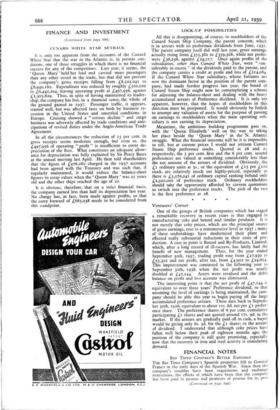FINANCE AND INVESTMENT It is only too apparent from the
accounts of the Cunard White Star that the war in the Atlantic is, in present con- ditions, one of those struggles in which there is no financial success for any of the competitors. Last year, it seems, the 'Queen Mary ' held her lead and carried more passengers than any other vessel in the trade, but that did not prevent the company's gross receipts falling from £8,222,041 to £6,940,160. Expenditure was reduced by roughly soo,000 to £6,442,204, leaving operating profit at £497,956, against £1,305,829. Thus, in spite of having maintained its leader- ship, the company has lost, in a financial sense, the whole of the ground gained in 1937. Passenger traffic, it appears, started well, but was affected later on both by business re- cession in the United States and unsettled conditions in Europe. Cruising showed a "serious decline" and cargo business was adversely affected by trade conditions and anti- cipations of revised duties under the Anglo-American Trade Agreement.
In all the circumstances the reduction of 15 per cent, in gross receipts seems moderate enough, but even so, the £497,956 of operating " profit " is insufficient to cover de- preciation of the fleet. What constitutes an adequate allow- ance for depreciation was fully explained by Sir Percy Bates at the annual meeting last April He then told shareholders that the figure of £976,280 charged in the 1937 accounts had been agreed with the Treasury and was such that, if regularly maintained, it would reduce the balance-sheet figures to scrap values when the 'Queen Mary' was 25 years old and the other ships reached the age of 20.
It is obvious, therefore, that on a strict financial basis, the company earned less than half its depreciation last year. No charge has, in fact, been made against profits, so that the carry forward of £685038 needs to be considered from this standpoint.










































 Previous page
Previous page